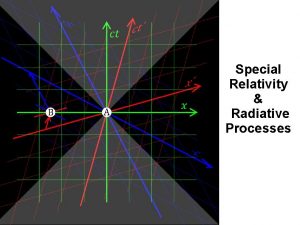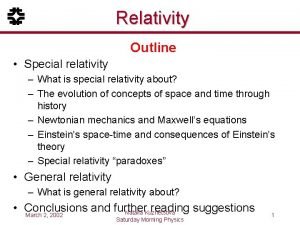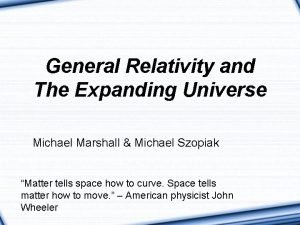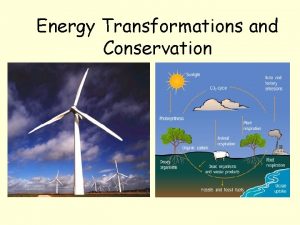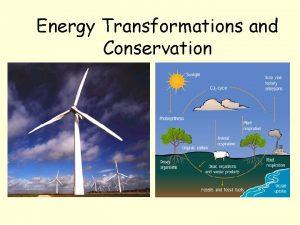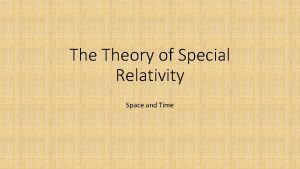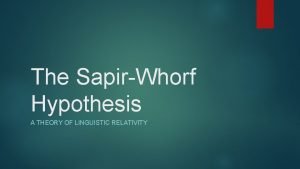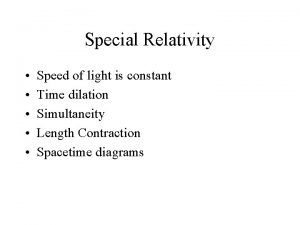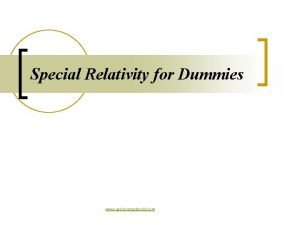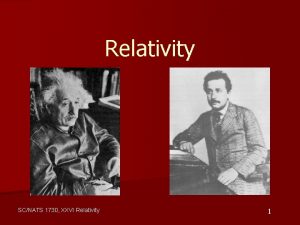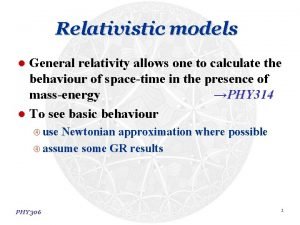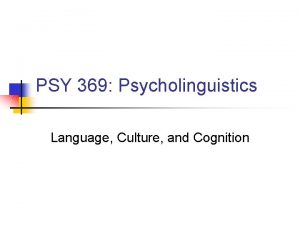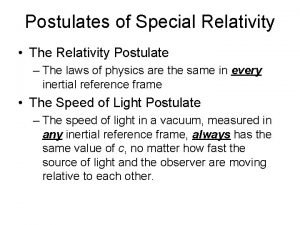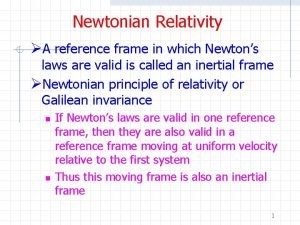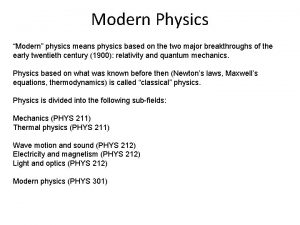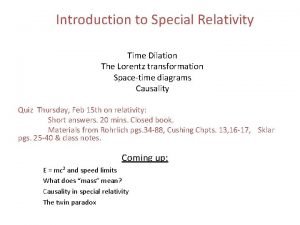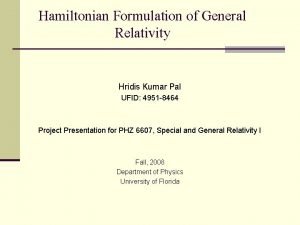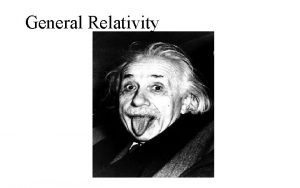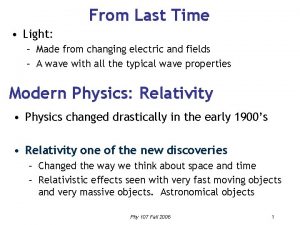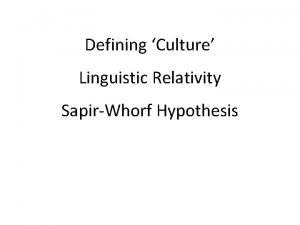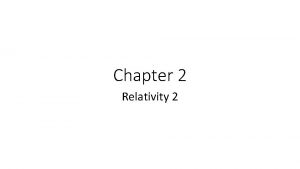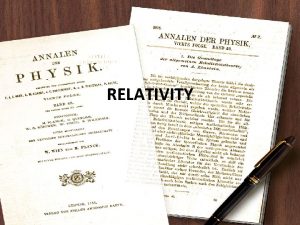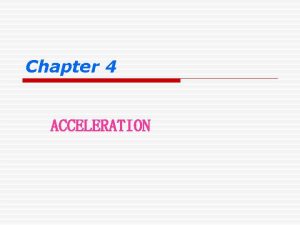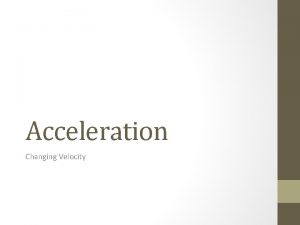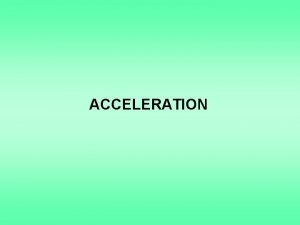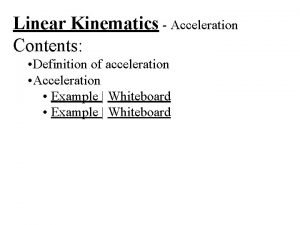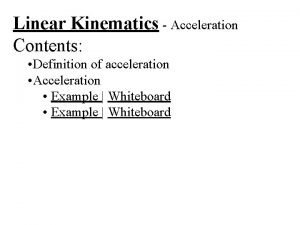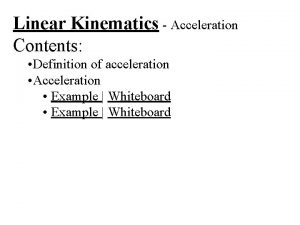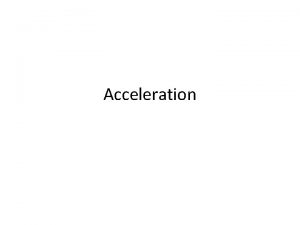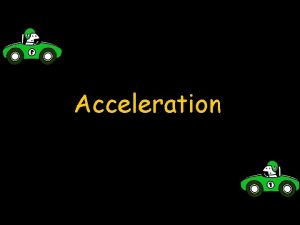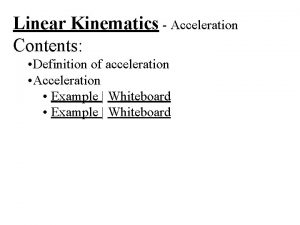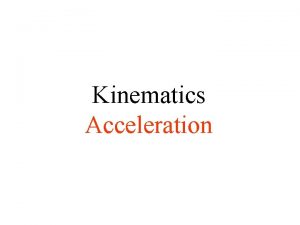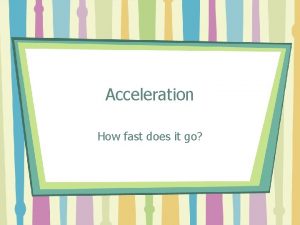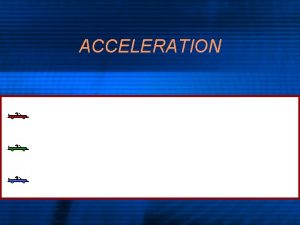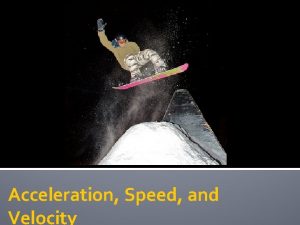Chapter 2 Relativity 2 Acceleration transformation Conservation of


























- Slides: 26

Chapter 2 Relativity 2

Acceleration transformation

Conservation of momentum • p is conserved in collisions • p approaches mu as u/c approaches zero. Momentum Conservation:

Momentum

Example • A high-speed interplanetary probe with a rest mass m = 50, 000 kg has been sent toward Pluto at a speed u = 0. 8 c. What is its momentum as measured by Mission Control on Earth? If, preparatory to landing on Pluto, the probe’s speed is reduced to 0. 4 c, by how much does its momentum change?

Relativistic Kinetic Energy • Total energy E of any isolated system is conserved • E will approach the classical value when u/c approaches zero Force: Kinetic Energy = Work done by the total force from rest. (1 D)

u/c approaches to zero (Energy) Binomial Expansion (or Taylor expansion) gives

Relativistic Total Energy u dependent u independent

Example • In Chapter 1, muons produced as secondary particles by cosmic rays were used to illustrate both the relativistic length contraction and time dilation resulting from their high speed relative to observers on Earth. That speed is about 0. 998 c. If the rest energy of a muon is 105. 7 Me. V, what will observers on Earth measure for the total energy of a cosmic-ray-produced muon? What will they measure for its mass as it moves relative to them?

List of rest masses of some particles • Electron (positron): 0. 5110 Me. V • Proton: 938. 272 Me. V • Neutron: 939. 565 Me. V • Muon: 105. 7 Me. V • See table 2 -1 on page 83 for more.

Lorentz Transformation of E and p Attention!

Example •

Mass and Binding Energy A system with two particles bounded together with certain binding energy. Everything is at rest. One particle Two separate particles Two bound particles m m m

Example • The binding energy of the hydrogen atom (the energy needed to remove the electron from the atom) is 13. 6 e. V. How much mass is lost when an electron and a proton form a hydrogen atom?

Invariant Mass Recall Invariant spacetime interval

Example •

System mass The rest mass of the system: 10 kg The total momentum of the system: 0

Massless particle For m = 0 • Remember that the rest energy of a system of particles is not the sum of the rest energies of the individual particles if they move relative to one another. This applied to photons too! Suppose two photons, one with energy 5 Me. V and second with energy 2 Me. V, approach each other along the x axis. What is the rest energy of this system?

Creation and Annihilation of Particles Energy Mass positron What is the minimum energy of the photon needed for the following to happen?

Example • What is the minimum or threshold energy that a photon must have in order to produce an electron-positron pair? Hint: the photon must hit something. Hint #2, in the minimum case, the created electron and positron carries no kinetic energy (at rest).

General Relativity • Einstein’s third postulate: A homogeneous gravitational field is completely equivalent to a uniformly accelerated reference frame.

Deflection of starlight – Gravitational lens Confirmed by Arthur Eddington in 1919 during total solar eclipse Simulated gravitational lensing (black hole going past a background galaxy).

Gravitational lens Simulated gravitational lensing (Interstellar (movie)).

Gravitational wave Explained by PHD Comics

LIGO (Laser Interferometer Gravitational. Wave Observatory) LIGO, Livingston, LA

Gravitational Wave Detected • Based on the details of the signal detected, the LIGO team estimates that the event that generated the gravitational waves occurred 1. 3 billion years ago. That's when two black holes, one 29 times the mass of the Sun, the second 36 times, spiraled into each other. When the collision took place, the equivalent of three times the mass of the Sun was converted directly to energy and released in the form of gravitational waves. For a brief fraction of a second, this single event produced more power than the entire rest of the visible Universe combined. • "This detection is the beginning of a new era: the field of gravitational wave astronomy is now a reality, " said Gabriela González of Louisiana State University. Black hole expert Kip Thorne stated, "With this new discovery, we humans are embarking on a marvelous new quest: the quest to explore the warped side of the Universe—objects and phenomena that are made from warped spacetime. " • To provide more precision to that astronomy, the LIGO collaboration will be integrating with the European Virgo detector, which is based on a similar approach. And negotiations are under way to build a LIGO-like detector in India. With four in operation, we'll someday be able to say something more than "somewhere in the Southern Hemisphere. "
 Special vs general relativity
Special vs general relativity General vs special relativity
General vs special relativity Special relativity vs general relativity
Special relativity vs general relativity Centripetal acceleration
Centripetal acceleration Relationship between angular and linear quantities
Relationship between angular and linear quantities Is radial acceleration the same as centripetal acceleration
Is radial acceleration the same as centripetal acceleration Linear acceleration
Linear acceleration Tangential acceleration and centripetal acceleration
Tangential acceleration and centripetal acceleration Energy transformation and conservation
Energy transformation and conservation Energy transformations and conservation
Energy transformations and conservation Theory of relativity
Theory of relativity Linguistic relativity definition
Linguistic relativity definition Special relativity
Special relativity Relativity for dummies
Relativity for dummies Postulates of special theory of relativity
Postulates of special theory of relativity Einstein thought experiment elevator
Einstein thought experiment elevator General relativity formula
General relativity formula Sapir whorf hypothesis
Sapir whorf hypothesis 2 postulates of special relativity
2 postulates of special relativity Teoria de la relatividad newton
Teoria de la relatividad newton Modern physics means
Modern physics means Law of relitivity
Law of relitivity Hamiltonian formulation of general relativity
Hamiltonian formulation of general relativity Relativity
Relativity Galilean relativity
Galilean relativity Time relativity interstellar
Time relativity interstellar Principle of linguistic relativity
Principle of linguistic relativity
